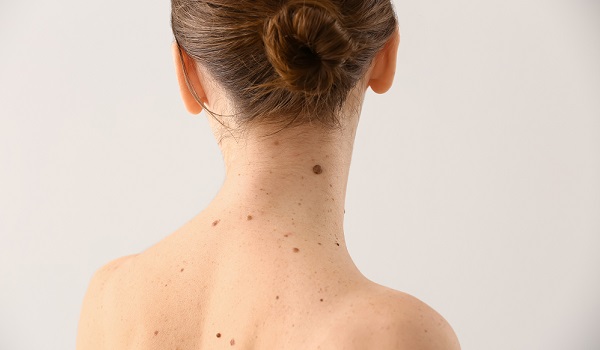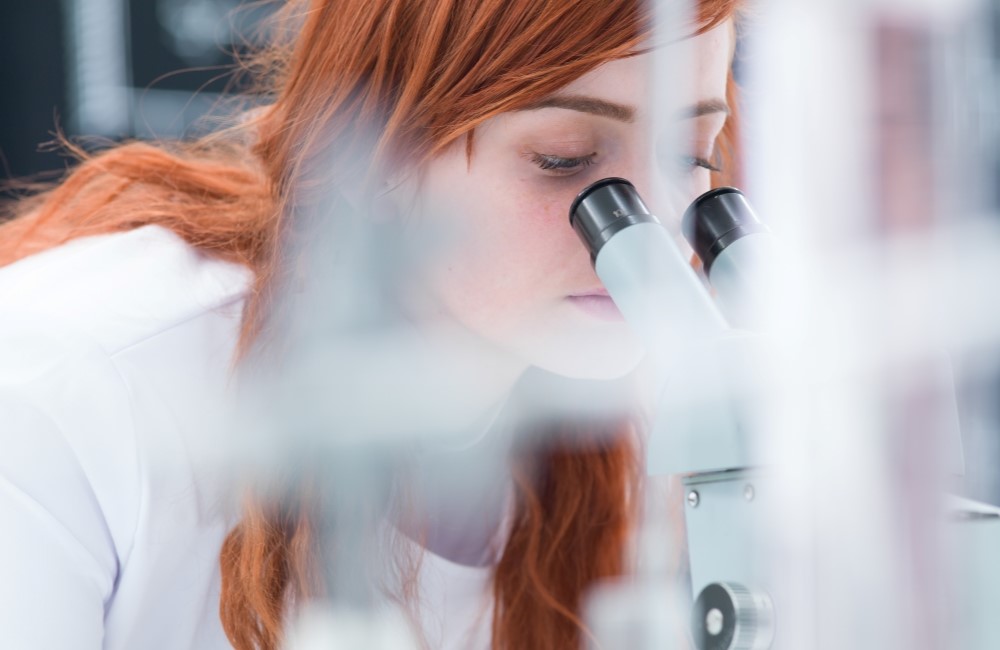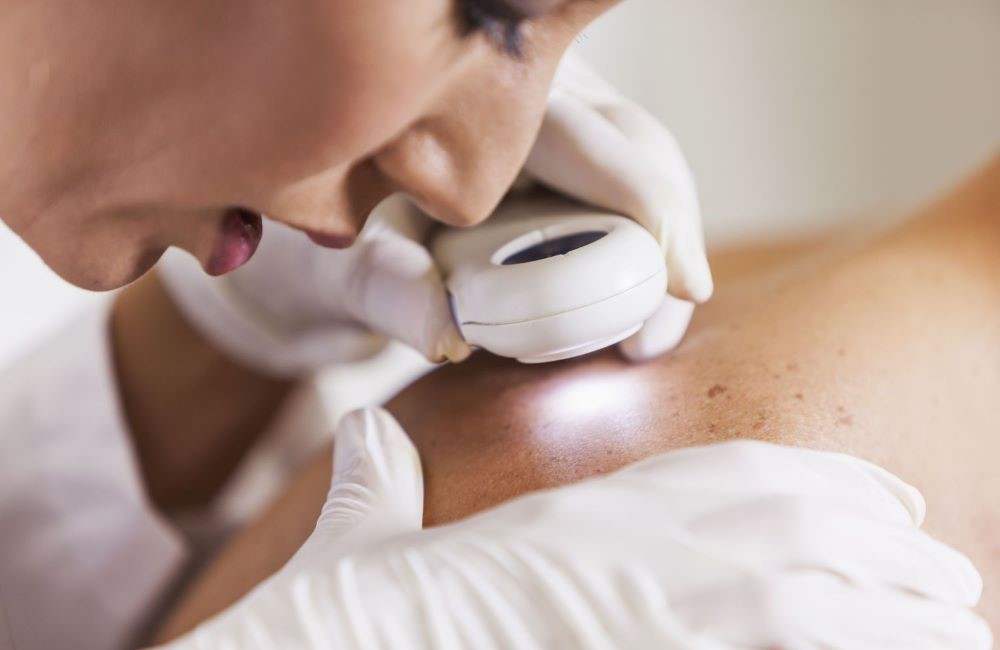What is
(black) Skin cancer?
Skin cancer is a broad term that covers various malignant skin diseases. The most common form is “white skin cancer”, while black skin cancer is considered far more dangerous. The symptoms and treatment of skin cancer vary depending on the type of disease. Find out more about the visual signs of (black) skin cancer, its possible causes and diagnostic procedures in this article. It also highlights the importance of early detection and preventive measures to reduce the risk of this serious disease.
About the symptoms
More information
Important facts about black skin cancer
The most common symptoms of skin cancer are
- Changes to existing moles: enlargement, irregular contours, color changes
- Appearance of new, unusual skin lesions or nodules
- Itching or pain in the area of the skin lesions
- Wounds that do not heal or bleed repeatedly
- Formation of ulcers or crusts on the skin
- Asymmetrical shape of moles or skin changes
- Changes in the texture or thickness of the skin
- Rapid growth of skin lesions
What are the most common forms of skin cancer?
There are different forms of skin cancer. The most common are:
- Basal cell carcinoma (basal cell cancer): Usually the most proliferative form, but rarely metastasizing.
- Squamous cell carcinoma (spinalioma): Can spread more quickly than basal cell carcinoma.
- Malignant melanoma (black skin cancer): Most aggressive form, tends to metastasize.
- Merkel cell carcinoma: Rare and aggressive form of skin cancer that affects the Merkel cells.
- Actinic keratosis (white skin cancer): Precancerous lesion that can develop into squamous cell carcinoma in some cases.
What are the causes and risk factors for black skin cancer?
The development of malignant melanoma is multifactorial and is influenced by a combination of genetic, environmental and individual risk factors. The main causes and risk factors include
Excessive UV exposure (and sunbed use)
Excessive UV exposure (and sunbed use)
Long-term and intensive sun exposure, especially sunburns during childhood or adolescence, increase the risk of skin cancer. Regular tanning in solariums is associated with an increased risk of skin cancer.
Light-skinned skin type
Light-skinned skin type
People with fair skin, blonde or red hair and lots of freckles have a higher risk of skin cancer as their skin offers less protection against UV radiation.
Skin lesions
Skin lesions
The presence of large or unusually shaped moles or pre-melanomas (such as lentigo maligna) increase the risk of malignant melanoma.
Family history
Family history
A familial predisposition to skin cancer can increase the risk, as certain genetic mutations can promote the development of melanoma.
Age factor
Age factor
The risk of malignant melanoma increases with age, with most cases occurring in people over the age of 50.
How is skin cancer diagnosed?
The diagnosis of malignant melanoma is usually made by a combination of a physical examination, the patient’s medical history and, in some cases, a tissue biopsy for examination under the microscope. Here are the steps of diagnosis in general.
The exact diagnosis is crucial for determining the stage and the treatment plan. If detected early, the chances of recovery are good, so it is important to have any suspicious skin changes examined immediately by a dermatologist.
Physical examination and medical history
Dermatoscopy
Biopsy
Imaging procedures

What to do about skin cancer
Prevention and early detection play a crucial role in dealing with malignant melanoma. These are important measures for prevention and early detection. The selection of the appropriate treatment method depends on various factors, such as the stage of the skin cancer, the size and location of the tumor and the patient’s individual health conditions. It is crucial that an experienced dermatologist or oncologist makes the diagnosis and determines the optimal treatment option for the individual patient.
Prevention
Avoid excessive exposure to the sun, especially during the intense hours of sunshine (usually from 10 am to 4 pm). Wear protective clothing such as long-sleeved shirts, hats and sunglasses. Regularly apply sunscreen with a sufficient sun protection factor (SPF 30 or higher) to all uncovered areas of skin. Avoid using sunbeds and solariums as they can increase the risk of skin cancer. Carry out a regular self-examination of the skin to detect suspicious changes or new skin lesions at an early stage.
Early detection
Have your skin checked regularly by a dermatologist or skin cancer specialist, especially if you have an increased risk of skin cancer. ABCDE rule: Pay attention to the ABCDE rule for self-examination of skin lesions: Asymmetry, irregular border, different colors, diameter greater than 6 mm, and evolution or change in the lesion. Early medical clarification: If you suspect skin cancer or notice any abnormal skin changes, consult a doctor immediately to obtain a precise diagnosis and, if necessary, treatment.
Treatment options for skin cancer
The treatment of white skin cancer, basal cell carcinoma and spinalioma, offers various procedures to choose from. The most promising method is usually an operation to remove the tumor. In some cases, scraping or icing the tumor may be sufficient. For some patients, however, alternative or complementary methods of skin cancer treatment are an option. These include radiotherapy and photodynamic therapy. These techniques can be used in addition to or instead of surgery, depending on individual circumstances and the progression of the skin cancer.
Sources
Please note that all content provided regarding individual medical conditions, treatments, procedures, etc. is general information and may vary depending on the physician:in and individual case and initial situation.
For more detailed information, please always consult your doctor.
Association of the Scientific Medical Societies in Germany (AWMF), German Cancer Society (DKG), German Cancer Aid (DKH). S3 guideline on the diagnosis, treatment and aftercare of melanoma. AWMF register no.: 032-024OL. 2020.
Federal Office for Radiation Protection (BfS). Optical radiation: Information for sunbed users. 2022
German Cancer Society (DKG), German Cancer Aid (DKH), Association of the Scientific Medical Societies in Germany (AWMF). Actinic keratosis and squamous cell carcinoma of the skin (S3 guideline). AWMF register no.: 032-022OL. 2020.
[4] Guideline program oncology (German Cancer Society, German Cancer Aid, AWMF): S3 guideline prevention of skin cancer, long version 2.1, 2021, AWMF register number: 032/052OL (retrieved on: 24.07.2023)
LinkGerman Cancer Society: "Malignant melanoma ("black skin cancer")", (last retrieval date: 24.07.2023)
Link